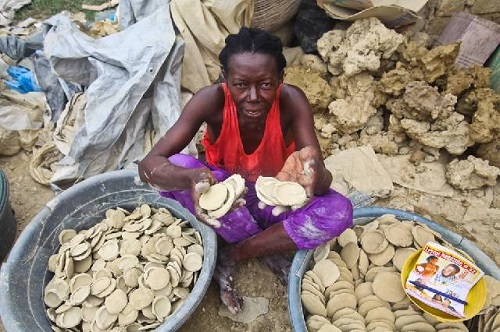

By Titilayo Kupoliyi
C is for Cookie, and that’s good enough for me. Cookie, cookie, cookie starts with C.”
It’s the song that defined the childhood of countless Western children – Sesame Street’s beloved Cookie Monster, tucking into his favorite sweet snack.
Cookies remain a beloved treat throughout America and beyond, with numerous kids looking forward to a daily serving.
The people of Haiti regularly eat cookies, too.
Sadly, the experience isn’t quite as enticing.
Haiti is one of the world’s poorest nations, with over 80% of the population living below the poverty line. This leaves the starving locals desperate for sustenance and creating cookies from mud simply to survive.
Well, it’s not exactly ideal, but sadly, the people of Haiti have no real alternative.
With food scarce and prices high, many Haitians are forced to create their own food from mud, with butter and salt added to make the snack comparatively palatable. In some cases, sugar may be applied, if it’s available.
As you can imagine, these ‘dirt cookies’ have virtually no nutritional value.
As the country already has the Western hemisphere’s highest rates of death in under-fives, that’s hardly ideal.
Haiti also has serious mortality issues surrounding respiratory infections, tuberculosis, and diarrhea, and eating dirt will do very little to alleviate this.
In the best case scenario, these mud cookies will bolster the weak immune systems of Haitians. With access to medication being very limited, the people of the country need to do all they can to help themselves.
At worst, however, eating soil can make somebody even sicker than they already are.
The water supply of Haiti is often contaminated. Naturally, this water will make its way into the soil as well as being drunk.
We want to make it abundantly clear that we don’t recommend or condone this. If you get sick as a result of this culinary experimentation, The Sized will carry no legal responsibility.
If you’re still determined to try this so that you can experience what life is like for the bottom end of the 99%, however, here’s how to do it.
- Dig up some dirt from your backyard or a similar location.
- Place it in a bowl.
- Add water. You’ll want roughly half as much water as you have dirt or mud.
- Sprinkle in some salt and butter or margarine. If you’re going to imitate a comparatively luxurious Haitian lifestyle, add some sugar too.
- Mix all of these ingredients by hand and mold them into cookie shapes.
- Place on a baking tray, and heat at around 180 degrees for 20 minutes.
This will give you a taste of Haiti, and hopefully, some perspective of just how challenging life is for the people of this nation. Mud cookies may not be appealing to the palate, but they’re all that stands between many Haitians and starvation.
Arizona Daily Star
If you hold the unwelcome title of the poorest country in the Western hemisphere, something has clearly gone very wrong somewhere along the way. Just how has Haiti ended up in such a state of economic turbulence?
The problems stem back to the 18th century when Haiti was a French colony that was exploited mainly for its slave labour.
The country had several sugar plantations, which were owned by a handful of precious fat cats.
This created an unequal distribution of wealth throughout the country that remains to this day.
Though not everybody in Haiti is so poor, they are reduced to eating dirt but many are.
NBC
Other countries have done little to help Haiti. France vacated the country in 1804 but insisted on being repaid the money they were owed due to lost slaves. It took Haiti until 1947 to repay this amount in full.
In between these dates, the USA had a turn at occupation early in the 20th century. Even after America moved out, it continued to meddle in Haitian politics. As the country has not enjoyed trustworthy governments over the years, this has hardly helped matters.
More recently, environmental disasters have devastated Haiti. In 2010, the country was rocked to its very core by an earthquake. International charities came to the rescue in theory. In reality, very little was achieved. Haiti was undoubtedly not “built back better,” as some catchy donation appeals claimed it would be.
This earthquake set Haiti back considerably. Any chance the nation then had of getting back on its feet was swept away in 2016, literally. Hurricane Michael rampaged through Haiti, destroying 90% of the homes on the coast and severely damaging hundreds of thousands of others.
Since these natural disasters, an outbreak of cholera has further decimated the country. Foreign assistance continues to pour in, but it seems that Haiti is consistently battling against a tide of ill fortune
Watch video
dollarsandsense.org/
Subscribe to our Telegram and YouTube Channels also join our Whatsapp Update Group